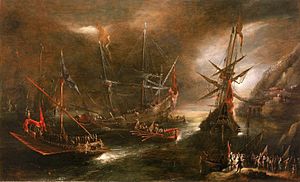Battle of Cartagena (1643) facts for kids
Quick facts for kids Battle of Cartagena |
|||||||
|---|---|---|---|---|---|---|---|
| Part of Franco-Spanish War (1635) | |||||||
 Paint illustration of embarkation of Spanish Troops |
|||||||
|
|||||||
| Belligerents | |||||||
| Commanders and leaders | |||||||
| Strength | |||||||
| 20 galleons 2 frigates 12 fire ships |
29 galleons 14 galleys |
||||||
| Casualties and losses | |||||||
| Low | 10 ships sunk 2 ships captured 3,000 men killed |
||||||
The Battle of Cartagena was an important naval battle. It happened on September 3, 1643, near Cartagena, Spain, off a place called Cabo de Gata. This battle was part of a bigger conflict known as the Thirty Years' War.
Contents
French Power at Sea
Before this battle, the French Navy was very strong in the western part of the Mediterranean Sea. They had won many battles in 1641 and 1642. France also controlled most of Catalonia, a region in Spain, after a conflict called the Catalan Revolt. Because of this, the Spanish Navy was afraid to sail near the Catalan coast.
The Search for the Spanish Fleet
In 1643, the French admiral Jean Armand de Maillé-Brézé decided to sail south. His goal was to find and destroy the Spanish fleet. He wanted to make sure the French Navy stayed in charge of the Mediterranean Sea.
He found a group of ships called Dunkirkers, led by Joos Petersen. There were also ships from Naples and a special group of ships from the Mar Oceano fleet, led by Martín Carlos de Mencos.
The Battle Begins
On September 3, at 7:00 AM, Admiral Maillé-Brézé attacked. The winds were in his favor, which helped his ships move quickly. The Spanish fleet was spread out and couldn't fight back easily.
The French sank two large Spanish ships called galleons. They also captured two other Spanish ships. The rest of the Spanish fleet had to quickly retreat into the port of Cartagena to escape.
Aftermath of the Battle
Once the Spanish ships were in the port, eight more of them were so badly damaged that they sank. The port was then closed off by the Duke of Fernandina. This meant no Spanish ship could leave the harbor for over a year.
Because of this, Spain could not trade by sea with Italy. This caused big problems for Spain. However, the French victory did not last very long. The French fleet became weaker after Cardinal Richelieu, a powerful French leader, died. Soon, Spain became strong in the region again.
See also
 In Spanish: Batalla de Cartagena (1643) para niños
In Spanish: Batalla de Cartagena (1643) para niños

